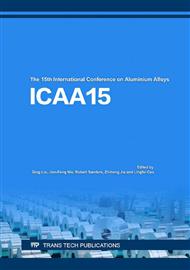[1]
D Samanta, N Zabaras, Control of macrosegregation during the solidification of alloys using magnetic fields. Int. J. Heat Mass Transfer. 49(25–26)(2006)4850-4866.
DOI: 10.1016/j.ijheatmasstransfer.2006.05.045
Google Scholar
[2]
Vista Metals Adds to Hard Alloy Super Slab and Homogenizing Capacity Record. LIGHT METAL AGE, 2005(6): 33-34.
Google Scholar
[3]
M O El-Bealy, Modeling of Heat Transfer and Interdendritic Strain for Exuded Surface Segregation Layer in the Direct Chill Casting of Aluminum Alloys. Metall. Mater. Trans. B. 47(1) (2016), 630-648.
DOI: 10.1007/s11663-015-0513-9
Google Scholar
[4]
A Noeppel, A Ciobanas, X D Wang, K Zaidat, N Mangelinck, O Budenkova, A Weiss, G Zimmermann, Y Fautrelle, Influence of Forced/Natural Convection on Segregation During the Directional Solidification of Al-Based Binary Alloys. Metall. Mater. Trans. B. 41(1) (2010).
DOI: 10.1007/s11663-009-9311-6
Google Scholar
[5]
D G Eskin, L Katgerman, Macrosegregation mechanisms in direct-chill casting of aluminium alloys. Mater. Sci. Forum. 630 (2010) 193-199.
DOI: 10.4028/www.scientific.net/msf.630.193
Google Scholar
[6]
M O El-Bealy, On the formation of extruded surface segregation layer in aluminum direct chill casting process. Canadian Metall. Quarterly, 49(1) (2010) 47-62.
DOI: 10.1179/cmq.2010.49.1.47
Google Scholar
[7]
R Nadella, D G Eskin, Q Du, L Katgerman, Macrosegregation in direct-chill casting of aluminium alloys. Prog. Mater. Sci., 53(3) (2008) 421-480.
DOI: 10.1016/j.pmatsci.2007.10.001
Google Scholar
[8]
M Ahmadein, M Wu, A Ludwig, Analysis of macrosegregation formation and columnar-to-equiaxed transition during solidification of Al-4wt. % Cu ingot using a 5-phase model. J. Cryst. Gr. 417 (2015) 65-74.
DOI: 10.1016/j.jcrysgro.2014.07.039
Google Scholar
[9]
B Zhang, J Cui, G Lu, Effects of low-frequency electromagnetic field on microstructures and macrosegregation of continuous casting 7075 aluminum alloy. Mater. Sci. Eng. A. 355(1-2) (2003) 325-330.
DOI: 10.1016/s0921-5093(03)00105-9
Google Scholar
[10]
J Dong, J Cui, X Zeng, W Ding, Effect of low-frequency electromagnetic field on microstructures and macrosegregation of Φ270 mm DC ingots of an Al-Zn-Mg-Cu-Zr alloy. Mater. Lett. 59(12) (2005) 1502-1506.
DOI: 10.1016/j.matlet.2005.01.009
Google Scholar
[11]
Z N Getselev, Casting in an electromagnetic mold. J. Met. 10(1971) 38-43.
Google Scholar
[12]
C Vives, Electromagnetic refining of aluminum alloys by the CREM process: Part I. Working principle and metallurgical results. Metall. Mater. Trans. B. 20(5) (1989) 623-629.
DOI: 10.1007/bf02655919
Google Scholar
[13]
J Dong, Z Zhao, J Cui, F Yu, C Ban, Effect of low-frequency electromagnetic casting on the castability, microstructure, and tensile properties of direct-chill cast Al-Zn-Mg-Cu alloy. Metall. Mater. Trans. A. 35(8) (2004) 2487-2494.
DOI: 10.1007/s11661-006-0228-2
Google Scholar
[14]
Y Zuo, J Cui, J Dong, F Yu, Effects of low frequency electromagnetic field on the as-cast microstructures and mechanical properties of superhigh strength aluminum alloy. Mater. Sci. Eng. A, 408 (2005) 176-181.
DOI: 10.1016/j.msea.2005.07.030
Google Scholar
[15]
Y B Zuo, H Nagaumi, J Z Cui, Study on the sump and temperature field during low frequency electromagnetic casting a superhigh strength Al-Zn-Mg-Cu alloy. J. Mater. Process. Technol. 197(1-3) (2008) 109-115.
DOI: 10.1016/j.jmatprotec.2007.06.020
Google Scholar
[16]
Y Zuo, J Cui, D Mou, Q Zhu, X Wang, L Li, Effect of electromagnetic field on microstructure and macrosegregation of flat ingot of 2524 aluminium alloy. T. Nonferr. Met. Soc. China. 24(7) (2014) 2408-2413.
DOI: 10.1016/s1003-6326(14)63364-1
Google Scholar
[17]
C J Vreeman, F P Incropera, The effect of free-floating dendrites and convection on macrosegregation in direct chill cast aluminum alloys: Part II: predictions for Al-Cu and Al-Mg alloys. Int. J. Heat Mass Transfer. 43(5) (2000) 687-704.
DOI: 10.1016/s0017-9310(99)00175-1
Google Scholar


